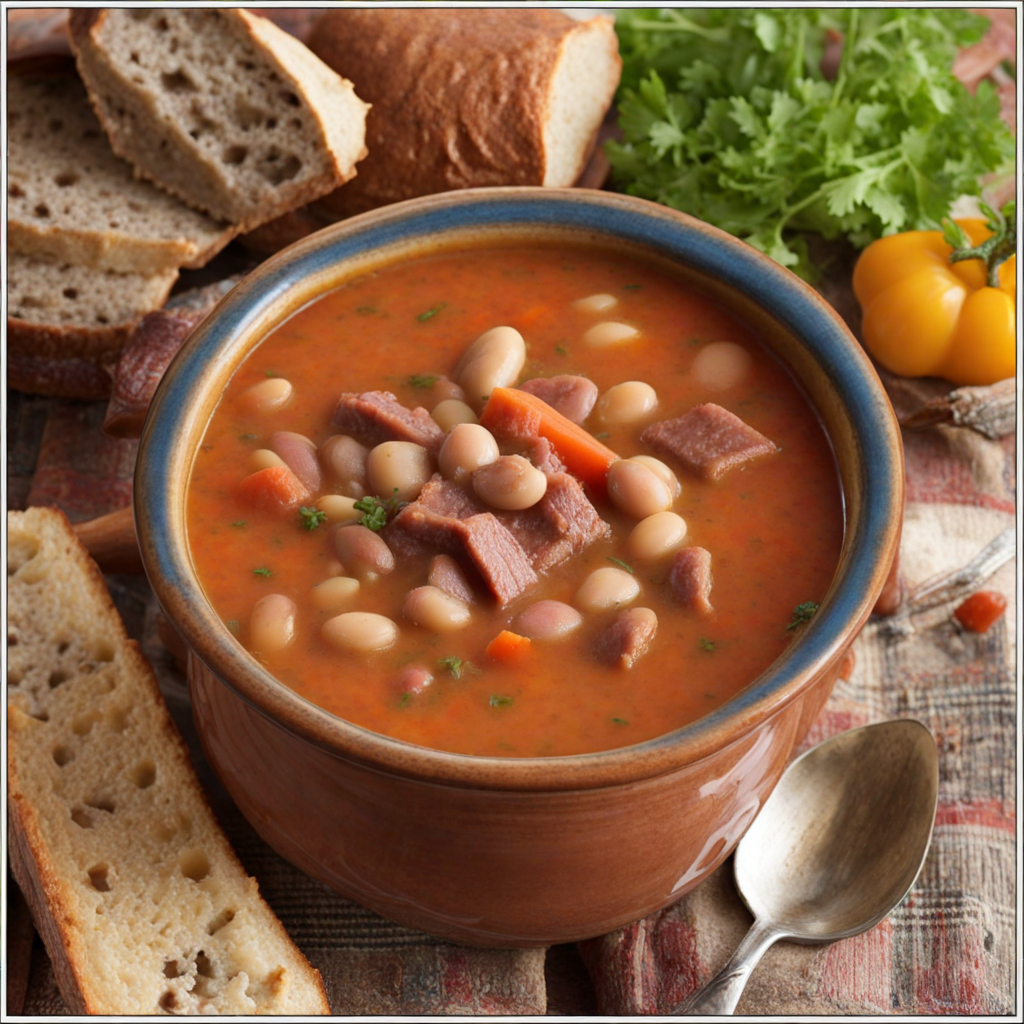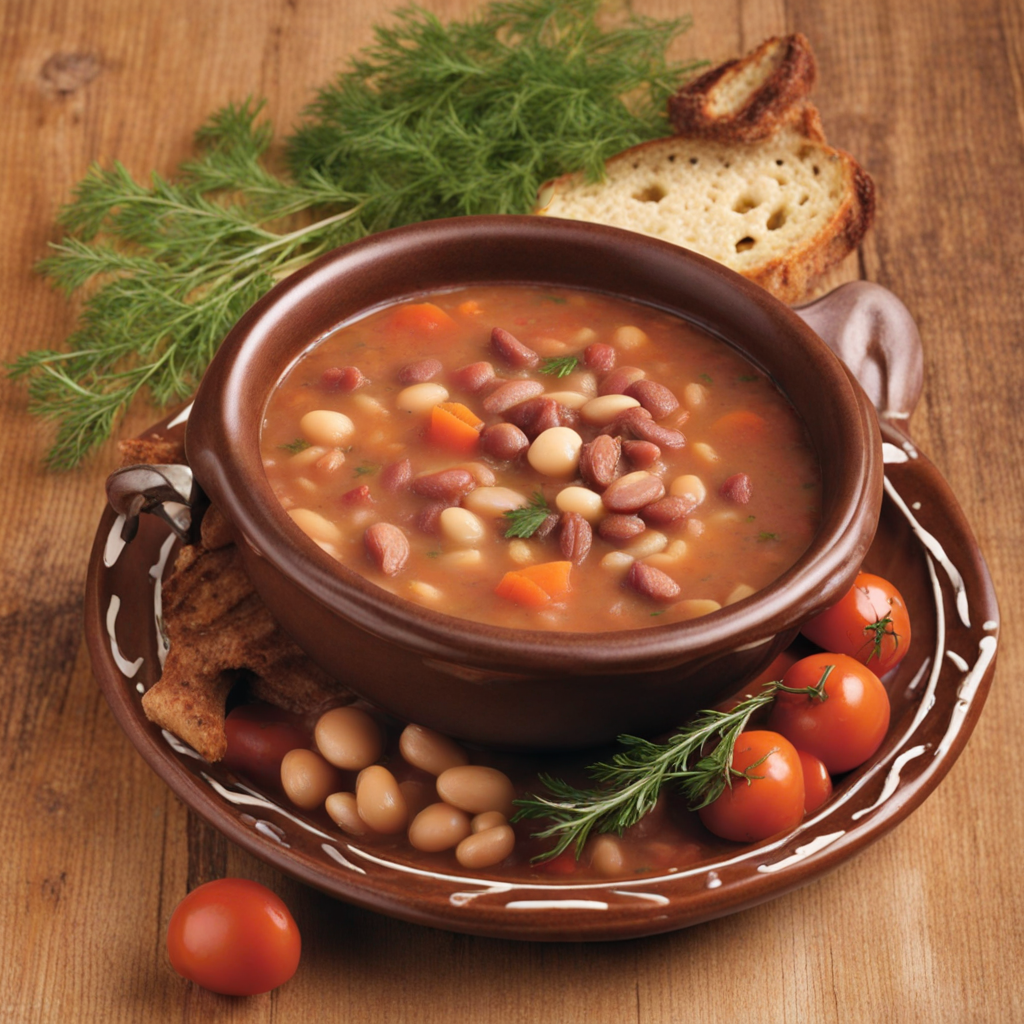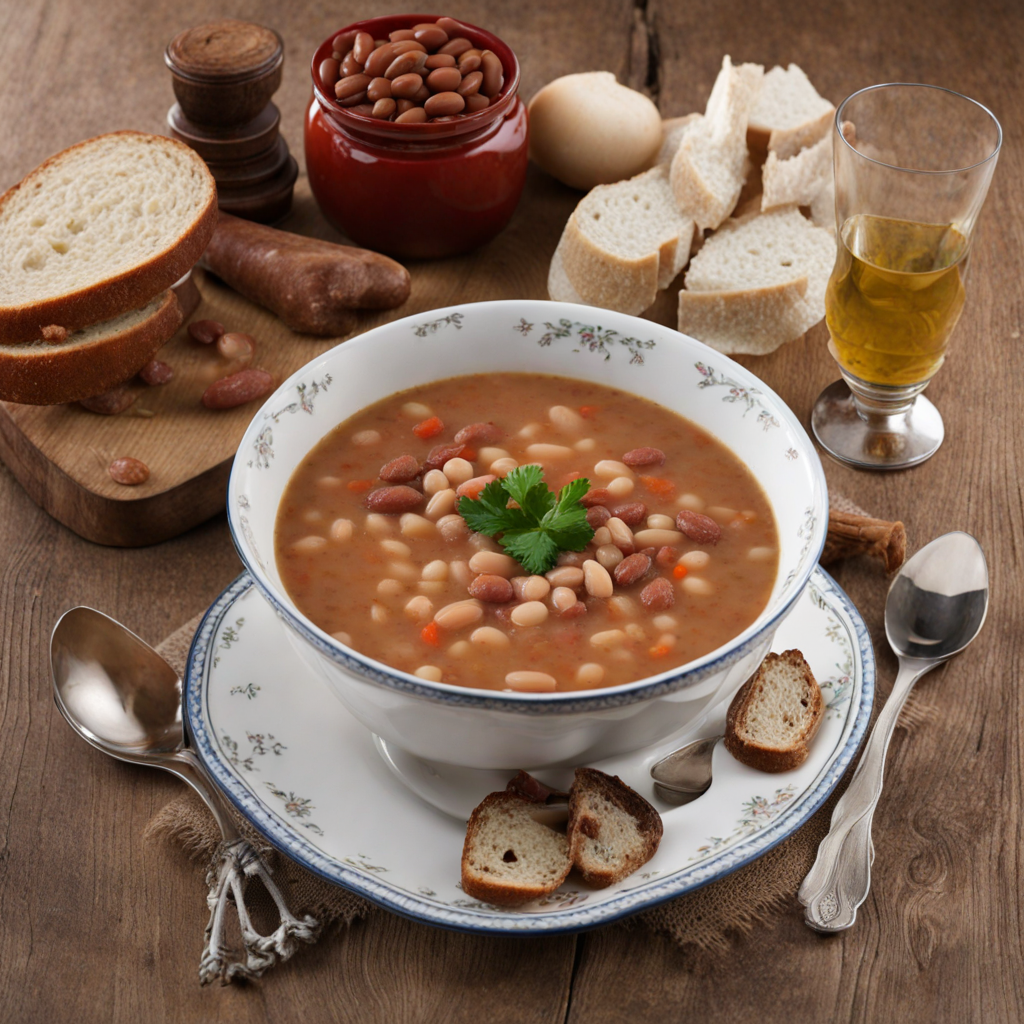Bableves
Bableves is a hearty and comforting bean soup that hails from Hungary, showcasing the rich culinary traditions of the region. This dish is primarily made with white beans, typically kidney or pinto beans, which are simmered to perfection. The beans are the star of the show, offering a creamy texture and a subtle earthiness that forms the foundation of the soup. The flavor profile is further enhanced by the addition of smoked meats, such as sausage or ham hock, which impart a smoky depth and savory richness to the broth. Fresh vegetables, including carrots, onions, and bell peppers, are also incorporated, adding layers of sweetness and color to the dish. The preparation of Bableves often involves sautéing the vegetables in a bit of lard or oil to release their natural flavors before adding the beans and broth. Traditional Hungarian spices, particularly paprika, play a crucial role in defining the taste of this soup, contributing a warm and slightly spicy kick. As it cooks, the soup thickens, allowing the flavors to meld beautifully, creating a dish that is both nourishing and satisfying. It's common to see a sprinkle of fresh parsley or dill as a finishing touch, which adds brightness and a hint of herbal freshness. Bableves is typically enjoyed as a main course, often served with crusty bread to soak up the delicious broth. This dish is not only a staple in many Hungarian households but also a reflection of the country's rich agricultural heritage, utilizing simple ingredients that come together to create something truly special. Whether you’re curling up on a chilly evening or gathering with friends and family, Bableves is sure to warm the soul and introduce you to the delightful flavors of Hungarian cuisine.
How It Became This Dish
Bableves: A Culinary Journey Through Hungary's Bean Soup Origins and Early History Bableves, a traditional Hungarian bean soup, has roots that stretch deep into the agricultural practices of the region. The word "bableves" literally translates to "bean soup," with "bable" meaning bean and "leves" meaning soup. Beans have been a staple crop in Hungary for centuries, thriving in the fertile soils of the Great Hungarian Plain. These legumes were not only a reliable source of nutrition but also a key component of the local diet for peasants throughout history. The earliest mentions of beans in Hungary can be traced back to the Middle Ages, when they were introduced from the Mediterranean region. They quickly became integrated into the Hungarian diet, favored for their versatility and ability to sustain rural families, especially during long winters. Accounts from the 16th century suggest that beans, particularly those cultivated in various Hungarian regions, were often featured in rustic soups prepared by the peasantry. Cultural Significance Bableves is more than just a dish; it embodies the essence of Hungarian culinary culture. It reflects the resourcefulness of the Hungarian people, who have learned to create nourishing meals from simple, locally available ingredients. The soup is traditionally made with dried beans—often pinto or white beans—combined with smoked meats, vegetables, and a variety of seasonings. In Hungary, food is deeply intertwined with identity and tradition. Bableves has become a symbol of comfort and home, often prepared in family kitchens and served at gatherings. It is a dish that transcends social classes, enjoyed by both the wealthy and the less fortunate alike. During the harsh winters, a hearty bowl of bableves was a reliable means of sustenance, providing warmth and nourishment to those who consumed it. Bableves is often enjoyed during special occasions and festivities, particularly during Lent when many Hungarians observe dietary restrictions. The dish is celebrated for its ability to be both filling and economical, making it a beloved choice during periods of fasting. Even today, bableves retains its place at the table during family gatherings and cultural festivities, serving as a reminder of Hungary's rich culinary heritage. Ingredients and Regional Variations While the core ingredients of bableves include beans, smoked meat (such as pork or sausage), and vegetables (like carrots, onions, and potatoes), regional variations abound. In the northern parts of Hungary, for instance, you might find the addition of local spices or even the inclusion of different types of beans. Each family often has its own recipe, honed over generations, which reflects personal tastes and regional influences. The soup is typically enriched with paprika, a spice that is synonymous with Hungarian cuisine. Paprika's introduction to Hungary in the 16th century marked a significant turning point in the country's culinary landscape. The vibrant red hue of paprika not only adds flavor but also symbolizes the warmth and heartiness of Hungarian dishes. The use of smoked paprika can lend a distinct depth to the bableves, enhancing its comforting qualities. Development Over Time As Hungary evolved through the centuries, so too did its culinary practices. The 19th century saw a burgeoning interest in national identity, and traditional dishes like bableves became emblematic of the Hungarian spirit. The Austro-Hungarian Empire's influence on Hungarian cuisine introduced new ingredients and techniques, yet bableves remained a steadfast staple, often served in homes and taverns alike. In the 20th century, particularly post-World War II, Hungary faced significant economic challenges. The importance of frugality in cooking became paramount, and dishes like bableves, which utilize inexpensive ingredients while still providing substantial nourishment, gained prominence. The soup became a symbol of resilience, demonstrating how traditional recipes could adapt to ever-changing circumstances. In contemporary Hungary, bableves continues to be a cherished dish that bridges the gap between past and present. While traditional recipes are still widely respected, modern interpretations have emerged, incorporating contemporary culinary techniques and ingredients. Chefs in upscale restaurants may elevate bableves by using artisanal beans, gourmet smoked meats, or creative garnishes, catering to a new generation of diners eager to explore the depths of Hungarian cuisine. Bableves in Contemporary Culture Today, bableves can be found in households across Hungary, as well as on the menus of restaurants that pride themselves on serving authentic Hungarian fare. It is not uncommon for families to gather around a pot of bableves, sharing stories and laughter as they enjoy the warm, hearty soup. In this way, bableves serves as a conduit for family bonding and community spirit, echoing its historical role in Hungarian society. Furthermore, the rise of food tourism has allowed for a renewed interest in traditional dishes like bableves. Visitors to Hungary are often encouraged to seek out local eateries and home-cooked meals that showcase the authentic flavors of the region. Culinary festivals celebrating Hungarian cuisine frequently feature bableves as a highlight, drawing attention to its cultural significance and inviting new audiences to appreciate the dish. Conclusion Bableves is a remarkable dish that embodies the heart and soul of Hungarian cuisine. Its origins rooted in the agricultural traditions of the country, combined with its rich cultural significance, make it a timeless staple that has evolved over centuries. From humble beginnings as a sustenance food for peasants to a beloved dish enjoyed by all, bableves is a testament to Hungary's culinary resilience and creativity. As Hungary continues to navigate the complexities of modern life, bableves remains a symbol of comfort, tradition, and community. Whether served in a rustic kitchen or an upscale restaurant, this flavorful bean soup invites everyone to partake in its rich history and celebrate the enduring legacy of Hungarian cuisine. In every bowl of bableves lies a story waiting to be shared—a narrative of heritage, resourcefulness, and the enduring bond between food and culture.
You may like
Discover local flavors from Hungary







